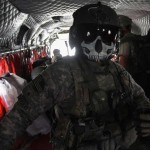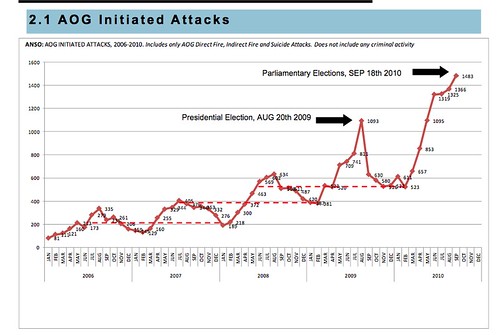 The White House is using its December review to try to spin the disastrous Afghanistan War plan by citing “progress” in the military campaign, but the available facts paint a picture of a war that’s not making us safer and that’s not worth the cost.
The White House is using its December review to try to spin the disastrous Afghanistan War plan by citing “progress” in the military campaign, but the available facts paint a picture of a war that’s not making us safer and that’s not worth the cost.
By Robert Greenwald at AlterNet
Let’s take a look at just the very broad strokes of the information. After more than nine years and a full year of a massive escalation policy:
- the insurgency continues to gain in size and strength,
- more U.S. troops are dying than ever,
- more civilians are dying than ever,
- violence in the country continues to spike,
- Pakistan is playing a double game with the U.S. and
- the military strategy lacks credible prospects for a turnaround.
And yet, we are told we can expect a report touting security gains and “progress,” and that there’s virtually zero chance of any significant policy change from this review. It sort of begs the question: just what level of catastrophe in Afghanistan would signal that we need a change in direction?
Insurgency Growing and Getting Stronger
This cat is already out of the bag, no matter how hard the Pentagon tries to reel it back in. In the ironically named “Report on Progress Toward Security and Stability in Afghanistan,” published several weeks ago, the Pentagon told Congress that the insurgency’s organizational and geographic reach are qualitatively and geographically expanding. This growth is reflected in other statistics. According to USA TODAY, U.S. troops were hit with 7,000 more attacks this year compared to last year. About 3,800 troops were killed and injured by IEDs, about 1,000 more than last year. These statistics depict an insurgency with unbroken momentum, despite administration and military claims to the contrary.
As the signers of the Afghanistan Call to Reason put it last week,
“Despite these huge costs, the situation on the ground is much worse than a year ago because the Taliban insurgency has made progress across the country. It is now very difficult to work outside the cities or even move around Afghanistan by road. The insurgents have built momentum, exploiting the shortcomings of the Afghan government and the mistakes of the coalition. The Taliban today are now a national movement with a serious presence in the north and the west of the country. Foreign bases are completely isolated from their local environment and unable to protect the population.”
The insurgents’ momentum is clearly shown by the number of attacks they’ve initiated across the country so far this year. According to the Afghan NGO Safety Office (ANSO),
“The [Taliban] counter-offensive is increasingly mature, complex & effective. Country wide attacks have grown by 59% (p.10) while sophisticated recruitment techniques have helped activate networks of fighters in the North where European NATO contributors have failed to provide an adequate deterrent (p.11). Some provinces here are experiencing double the country average growth rate (p.12) and their districts are in danger of slipping beyond any control. Clumsy attempts to stem the developments, through the formation of local militia’s and intelligence-poor operations, have served to polarize communities with the IEA capitalizing on the local grievances that result. In the South, despite more robust efforts from the US NATO contingents, counterinsurgency operations in Kandahar and Marjah have similarly failed to degrade the IEA’s ability to fight, reduce the number of civilian combat fatalities (p.13) or deliver boxed Government.”
Here’s a helpful chart from ANSO’s report that shows the level of ever-escalating insurgent attacks across Afghanistan.

The White House wants to weasel out of the implications of the data above by saying that the reason the statistics are going south is because, as Petraeus so often says, “when you take away areas important to the enemy, the enemy fights back.” So, we’re “on offense,” as President told troops few weeks ago during his trip to Afghanistan. Well, so what? The 1976 Buccaneers went on offense, too, but that didn’t mean they won games.
When the administration claims that they’re seeing “progress” in pockets of southern Helmand and Kandahar (a claim open to serious dispute, by the way, and strangely contradicted by some of Petraeus’ own spin), they’re displaying a familiar kind of confusion between the tactical and the strategic, one that seems to always pop up when we’re confronting a failed war.
“One of the iconic exchanges of Vietnam came, some years after the war, between Col. Harry Summers, a military historian, and a counterpart in the North Vietnamese Army. As Summers recalled it, he said, ‘You never defeated us in the field.’ To which the NVA officer replied: ‘That may be true. It is also irrelevant.’”
Pakistan’s Double Game
That brings us to Pakistan. According to the New York Times, two new National Intelligence Estimates “offer a more negative assessment [than the administration’s upcoming review] and say there is a limited chance of success unless Pakistan hunts down insurgents operating from havens on its Afghan border.” But that’s some serious wishful thinking, since Pakistan has long used the Taliban as a cat’s paw to combat growing Indian influence in Afghanistan. Pakistan wants the militants who threaten it internally suppressed, but it finds the militants who threaten the Karzai regime useful. Fixing that problem would requite U.S. policy follow the roots of their support of the Taliban all the way up to the India/Pakistan animosity, and nothing–nothing–in the U.S.’s military-first strategy comes close to doing so.
Troops Pay the Price
While U.S. politicians nibble at the edges of this real crisis, U.S. troops pay the bloody price, a price that’s gotten much worse with the arrival of the new escalation policy over the course of this year. At least 874 American troops have been killed in the war so far this year, compared to 317 for all of 2009. In the NATO hospital near Kandahar, doctors performed a major amputation once very other day in September.
These statistics go hand-in-hand with the huge rise in civilian casualties, which number some 2,400 this year so far, according to the Campaign for Innocent Civilians in Conflict.
Time for the White House to Get Real
The Obama Administration is kidding itself if it thinks the American people will buy this attempted whitewash of the failure of the escalation strategy in Afghanistan. We are in the grips of a desperate unemployment crisis, wrapped in a larger economic meltdown. We are not ignorant of the $2 billion dollars sent per day on the war, and we want that money, and those young people, back here at home so we put people back to work.
Following the death of Ambassador Richard Holbrooke, the president should take a step back and realize that we all have to travel down that road some day. He should think about what legacy he wants to leave behind him. Postponing a final end to U.S. military action in Afghanistan until 2014 puts U.S. taxpayers and American troops on the hook for an enormous investment of blood and treasure in a failing enterprise with no prospects for a turnaround.
A real, honest review would objectively conclude that the enterprise is failing and that the best alternative is to start removing U.S. troops immediately to stave off continued economic and social damage caused by this war that’s not making us safer nor worth the cost.
– Please watch latest video and share it with your friends. Then, join Rethink Afghanistan on Facebook and Twitter.
ATTENTION READERS
We See The World From All Sides and Want YOU To Be Fully InformedIn fact, intentional disinformation is a disgraceful scourge in media today. So to assuage any possible errant incorrect information posted herein, we strongly encourage you to seek corroboration from other non-VT sources before forming an educated opinion.
About VT - Policies & Disclosures - Comment Policy



